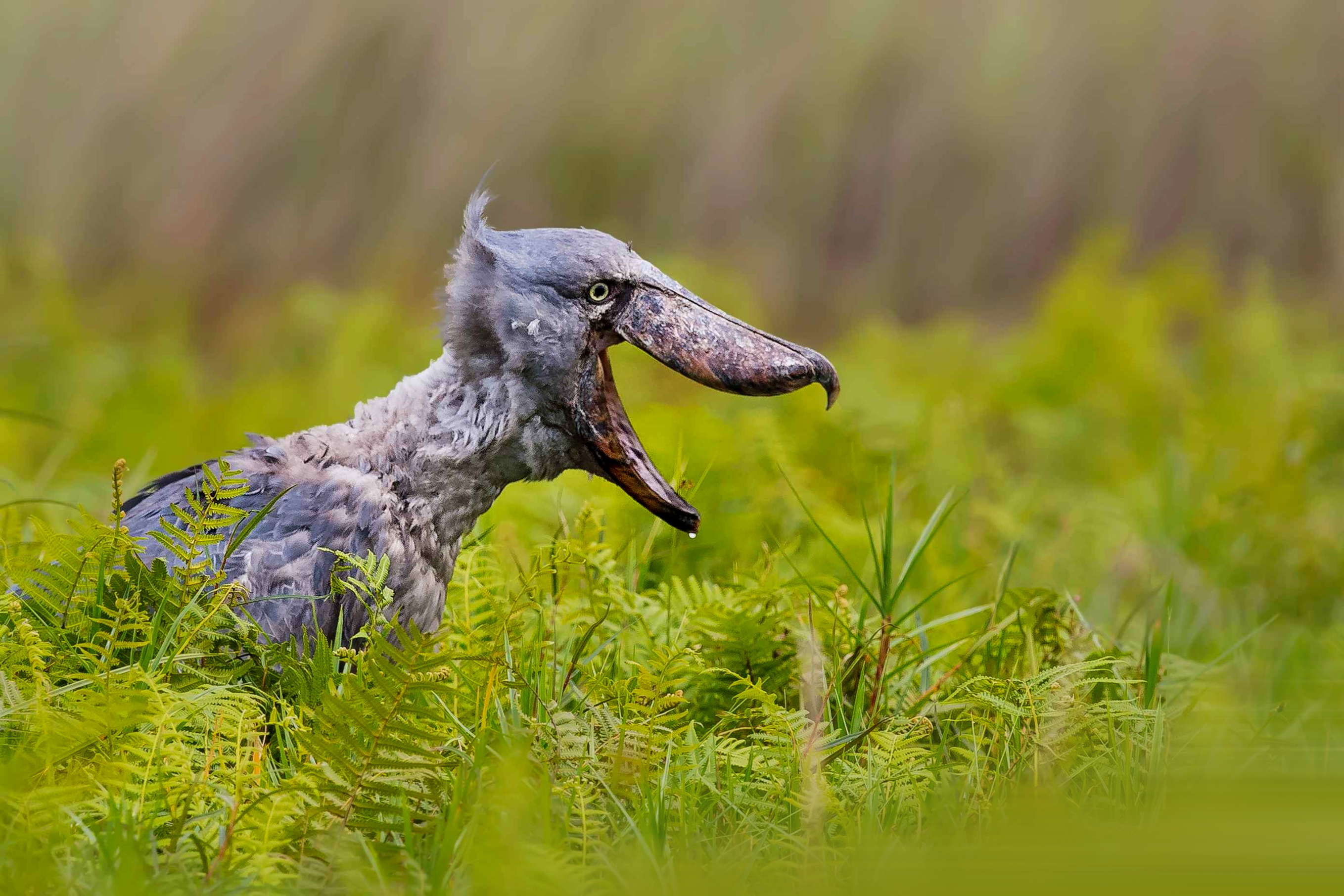
Basics
- Shoebills are large African birds named after their huge shoe-like bill.
- They’re one of the only members of their genus. The only other member of their family is the hamerkop, named after their hammer-like head.
- They have historically been linked with storks, but they’re closer to herons, ibis, and pelicans than to storks.
- Perhaps interestingly, before DNA testing was commonplace, one of the first clues about their place in the bird family tree was that their eggs have pretty much the same eggshell, or “crystallized eggshell and the accessory material (cuticle and cover) located in the outer surface of the shell”. (for an illustration, see Addendum 1)
- They live in eastern Africa, usually in swamps, from Sudan to Zambia. But some vagrants have been spotted as far west as the Congo River.
- 50 to 80% of the population lives in South Sudan. There are about 5,000 shoebills there.
- Their population is declining in some parts of its range.
Evolution
- The only confirmed ancestor of the shoebill is the Golithia.
- A giant bird who could be over 2 meters tall.
Biology
- Shoebills are huge. Adults can reach 140 cm. And the tallest one ever found was 152 cm tall. That’s as tall as Dolly Parton.
- Their wingspan ranges from 230 cm to 260 cm. For context, Lebron James’ wingspan is 218 cm, shorter than an adult shoebill’s. Their wings are broad and good for soaring.
- When flying, they retract their necks, like pelicans.
- Their wings flap about 150 times a minute, which is among the lowest among all birds.
- But despite their size they only weigh about 4-7 kg, which is a testament to bird’s light hollow bones.
- At 24 cm, they have the third longest bill after pelicans and storks.Their bill has a bigger circumference than the aforementioned birds.
- The side edges of the bill are sharp, which help them decapitate their prey and mow grass to expose prey.
- The upper mandible has a very sharp nail at the end.
- Their feet are also huge, which is helpful when you live in a swamp. The middle toe can be 18 cm long.
Behaviour
- Shoebills like swamps with mixed vegetation. But they’re sometimes seem in some other environments such as farms.
- They’re known for being able to stand still for a long time, often hours as they wait for prey.
- They’re also mostly sedentary, but will sometimes move as water levels change.
- They’re sensitive to people and can abandon a nest if disturbed by humans.
- Because they’re so light (relatively) they can stand on floating vegetation to go fishing.
- Some of the plants most associated with shoebills are papyrus, cattails, and reeds.
- They’re solitary hunters and seek quiet, muddy, areas to wait for fish to come near the surface. Once they spot a potential prey, they lunge at it quickly.
- Apparently hippos scare fish and force them to go to the surface. So shoebills like to hunt in areas with hippos.
- Their diet consists of fish. Two of the species they’re known to eat are the lungfish and the bichir. These are cool species because they can breathe outside of the water too. So the poor fishes see a scary fish and get out of the water, and then wham, they get eaten by a giant shoebill.
- They’re no specialized predators, and will anything they can catch, including frogs, snakes, lizards, and young crocs.
- Some fish estivate in burrows and the shoebill uses its huge beak to dig them out.
- Shoebills are territorial when it comes to nests. They nest far away from other shoebills and will fight other shoebills that get too close.
- They’ll also fight off predators, including crocs.
- The nests are about 1.5 m wide and are made of aquatic vegetation.
- They’re monogamous.
- When the babies hatch, they feed them regurgitated food, mostly lungfish and bichir.
- They can lay more than one egg and will hatch them all, but usually only raise the strongest baby.
- Babies have to start fighting each other early to be chosen as the one worthy of being raised.
- Babies become able to fly at about 16 weeks, but will still be fed by their parents for a few more weeks.
- They become sexually mature at 3 years of age.
- They don’t really make a lot of noise other than bill clattering near the nest, or when greeting other shoebills.
- Check this out
- Check this out too
- There are also reports of baby making hiccup-like sounds and adults making threatening calls at marabou storks.
Quick Facts
- Their population is threatened because of hunting, nesting disturbance, and the destruction or modification if its habitat.
- In some parts, like Tanzania, they’re hunted for food and for the zoo trade.
- They can live over 30 years in the wild.
- Some sources said that it appeared in Ancient Egyptian art. It would make sense since their empire extended all the way south to Sudan. But I couldn’t find any pics or confirmation.
Bowing…

